A Summer Tour today, in North Norfolk. It was a gloriously sunny day, but with a fresh breeze never got too hot or humid. A lovely day to be out birding. We met up at the car park at Cley and while we were loading the car, we could see our first Spoonbill of the day out on the scrapes. A forerunner of things to come!
 Spoonbill – our first of the day, from the car park at Cley
Spoonbill – our first of the day, from the car park at Cley
We headed up to the Heath first, hoping to make the most of it before it got too hot and too busy. As we walked out along the path, we could hear Willow Warblers and Whitethroats singing. A Yellowhammer added its voice to the chorus – a ‘little-bit-of-bread-no-cheese’. Little family groups of Linnets were flying around among the gorse. We could hear a pair of Bullfinch calling softly, but they flew off across the Heath to cover as we approached.
We could hear the delicate purring of a Turtle Dove, but we couldn’t see it at first, hidden amongst the birch trees. The next thing we knew it appeared at the very top of one of them and set up in the sunshine giving us a great view. We could see its neck puffing out as it purred. Then it launched itself into a display flight, flying up with a quick burst of flapping, then gliding round in circles over the trees before dropping down onto the same perch as before. With the population of Turtle Doves in the UK collapsing, how much longer will we be able to enjoy such a beautiful sound and sight?
 Turtle Dove – purring and display flighting
Turtle Dove – purring and display flighting
While we were watching the Turtle Dove, a Garden Warbler burst into song nearby. We listened to it for a minute of so, noting the faster, rolling cadence than a Blackcap. We worked our way round behind it, onto main path. A Cuckoo flew over quietly and disappeared between the trees. We found the Garden Warbler amongst the birches, and got a quick view of it perched out, but it was darting around quickly. A second bird singing nearby.
As we walked on around the Heath we could hear Woodlarks calling. It sounded as if they were further away, but suddenly one flew a short distance along the verge in front of us. Woodlarks have a remarkable ability to throw their voice. We could just see it feeding down amongst heather. It was obviously nervous at our presence and even though we stood still it took off. Another two Woodlarks followed it up from the ground – a family party, with a well grown fledgeling. They landed a little further over in a clearing, but once we got round there we couldn’t find them again. Presumably they had walked off through teh grass feeding. Another Turtle Dove was purring from the trees.
We had seen a male Stonechat perched in the top of some dead trees in the clearing as we approached, so we walked over to look for it. There was no sign initially, but someone with a camera had just walked right through the middle of the grass. With Woodlarks nesting on the ground in the area, this is never the most sensible thing to do. We stuck to the path, and the male Stonechat reappeared behind us on a fence post. Two Woodlarks then flew in next to it, a nice combination through the scope! The Woodlarks flew back towards where we had disturbed them earlier and then a female Stonechat appeared as well. A Green Woodpecker called nearby, but flew off towards the woods.
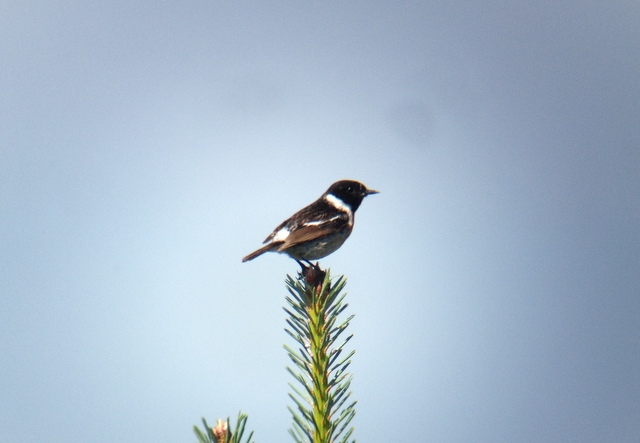 Stonechat – the male performed for us as we stayed on the path
Stonechat – the male performed for us as we stayed on the path
It seemed a perfect day for the Dartford Warblers – bright and not too breezy. However, we tried walking around several territories but all was quiet today. The birds are onto their second broods now so perhaps the males have taken a break from territorial duties. On our way back, we saw one of the Woodlarks again, heading back towards the favourite area carrying food. It landed on a fence post nearby, watching us nervously.
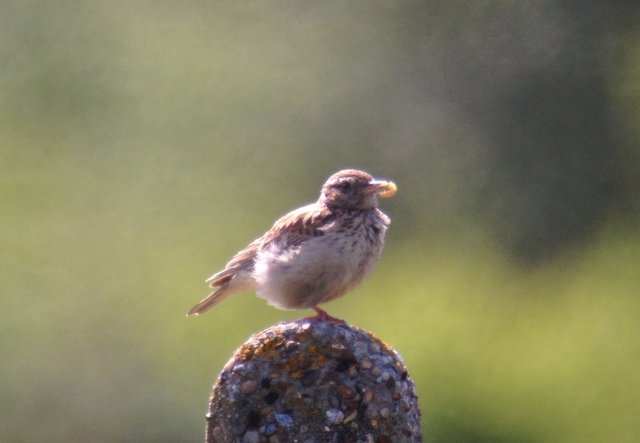 Woodlark – we found a family party with well grown fledgeling
Woodlark – we found a family party with well grown fledgeling
As we headed back to the car, a Hobby appeared flying low over the Heath. It looked to be carrying prey, and disappeared off over the trees. We saw lots of Silver-studded Blues as well today, fluttering around in the low vegetation in the grass and mown areas.
 Silver-studded Blue – lots were on the wing today
Silver-studded Blue – lots were on the wing today
We drove round via the coast road and stopped down at Salthouse by the Iron Road next. The pools here have been very productive this year, with the higher water levels. However, the vegetation has now grown up a lot and it is harder to see the birds! We found a Curlew hiding in the reeds along the main drain – one of the many waders which has already been returning in the last few days. There were several Sand Martins flying low over the water hawking for insects.
We had seen lots of birds on one of the other pools as we drove up, so we walked up to Sarbury Hill to get a better view. A Spoonbill was out on one of the pools, doing what Spoonbills do best – sleeping. There was also a large gathering of big gulls, with both Great and Lesser Black-backed Gulls, as well as the regular Herring Gulls. The panorama of the coast from here was stunning, looking down over the new pools at Pope’s Marsh.
 Pope’s Marsh – a great view of the new pools from Sarbury Hill
Pope’s Marsh – a great view of the new pools from Sarbury Hill
After lunch, we headed out onto the reserve at Cley. There were still lots of Reed Warblers singing from the reeds. The regular, obliging Reed Bunting perched in its usual bush right by the boardwalk, singing.
 Reed Bunting – singing in its favourite bush again today
Reed Bunting – singing in its favourite bush again today
The main Spoonbill gathering was on Simmond’s Scrape. Nine of them were out on the grass doing guess what? Yes, sleeping! They did wake up at times, shaking their heads, having a quick preen, before resuming their favoured activity. When they did wake, we could see there were both adults and juveniles in the group, the latter with shorter, fleshy-coloured bills, lacking the adults yellow bill-tips. As we scanned, we could see another Spoonbill was asleep on its own down in the longer grass on one of the islands and another, possibly the same bird that we had seen first thing this morning, was still asleep on Pat’s Pool.
 Spoonbill – an adult and juvenile both awake
Spoonbill – an adult and juvenile both awake
When another adult Spoonbill flew in to join the group, one of the juveniles woke up and immediately set off after it, bobbing it head up and down rhythmically. However, the pursuit seemed a little half-hearted today – perhaps the juvenile had only recently been fed, and the adult got to settle down and go to sleep. Before it did so, we noted that it was colour-ringed. Spoonbills from colonies in places such as France and the Netherlands have been noted along the coast here, but this individual seemed to have lost a lot of its rings, so might be hard to track down.
 Spoonbill – a colour-ringed adult flew in to join the roosting group
Spoonbill – a colour-ringed adult flew in to join the roosting group
There were lots of other birds to look at on the scrapes today as well. Waders have been returning south steadily in the last week or so – autumn is already upon them, as non-breeders and failed breeders leave the breeding grounds early. Consequently, the variety of waders along the coast has already picked up. Four Greenshank were roosting along the bank of one of the islands and a blackish shape asleep on the grass behind was a moulting summer plumage dark male Ruff.
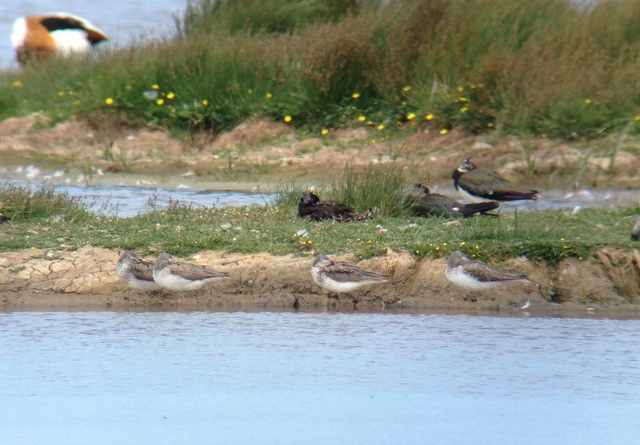 Greenshank & Ruff – some of the returning waders on the scrape
Greenshank & Ruff – some of the returning waders on the scrape
Out on Pat’s Pool, another black wader was feeding. A Spotted Redshank, again in pretty much full summer plumage still. They always look stunning in this plumage – through the scope we could see the white spangling above and the needle-fine bill. We even had it next to a Common Redshank at one point, given a great comparison between the two.
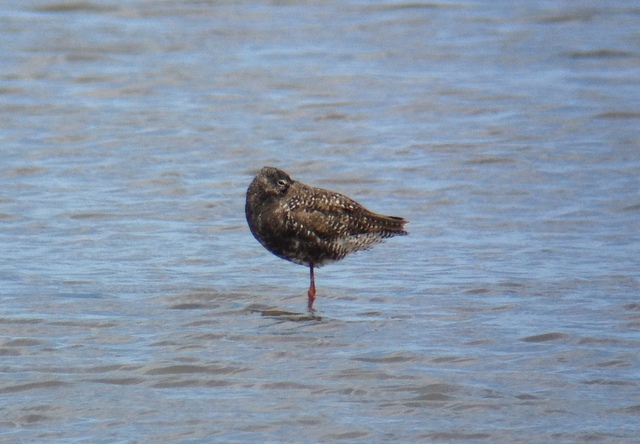 Spotted Redshank – always stunning in summer plumage
Spotted Redshank – always stunning in summer plumage
There have been several 1st summer Little Gulls along the coast for several weeks now. Today was no exception, with two out on Pat’s Pool. The amount of black hood acquired by 1st summer Little Gulls varies from individual to individual and one of the two today had a nice partial jet black hood.
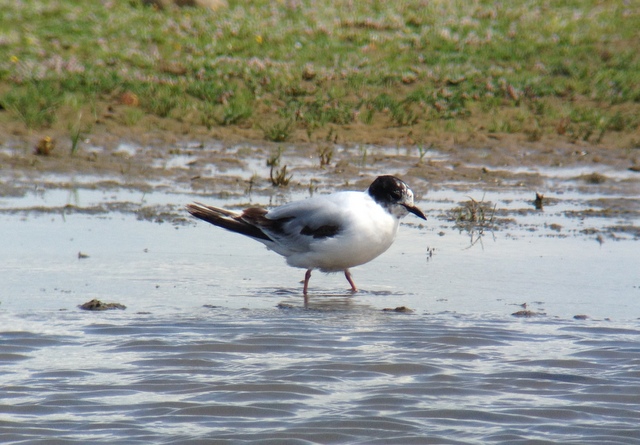 Little Gull – a 1st summer sporting a partial jet black summer hood
Little Gull – a 1st summer sporting a partial jet black summer hood
There are also increasing numbers of ducks again along the coast. More Teal in particular have been in evidence again in recent days. In contrast, Shoveler and Gadwall have been around right through so may just be more obvious now as birds gather to moult. Scanning through them, we found the male Garganey that has been out on Pat’s Pool for a couple of days. It is in the process of moulting into eclipse plumage, with a rusty orange face and a partial pale supercilium ghosting the pattern of the spring male.
The Marsh Harriers can normally be relied upon to put on a good show, and today was no exception. One of the females was hunting along the reedy channel out in front of the hide, and kept flying down right towards us giving us great close-up views.
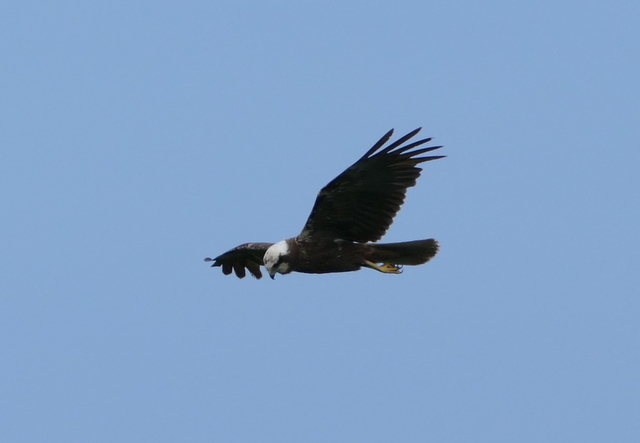 Marsh Harrier – hunting in front of the hide today
Marsh Harrier – hunting in front of the hide today
We were just packing up to leave when a group of Black-tailed Godwits flew in over on the other side of Pat’s Pool. A quick look through binoculars and we could see that one of the group looked noticeably larger and longer legged than the rest. We got it in the scope and had a good look at it. Most of the Black-tailed Godwits are Icelandic breeders – of the subspecies islandica. This was a moulting adult Continental Black-tailed Godwit – of the subspecies limosa. Subtly different from the Icelandic birds, it is always an interesting exercise to try to pick out one of the small numbers of limosa which appear at this time of year from amongst the islandica.
We walked round to Bishop Hide to get a closer look and were just in the process of admiring the Continental Black-tailed Godwit when all the waders suddenly took to the air. A Marsh Harrier had drifted over from the reedbed and spooked them. All the Avocets and godwits landed at the back of the scrape and we could see there were now two different moulting male Ruff, including the dark bird we had seen asleep earlier. Individual males differ markedly in the colour of their plumage.
From Bishop Hide we walked round to the East Bank. There are still lots of Lapwings, Redshank and Avocets out on the pools on the grazing marsh. However, they do a very good job of chasing off anything which comes near them. Further along, we could see another big flock of Black-tailed Godwits roosting in the grass. Yet another moulting male Ruff, this one a different colour again, was feeding unobtrusively along the bank of the Serpentine.
 Spoonbill – this adult was feeding on the Serpentine
Spoonbill – this adult was feeding on the Serpentine
Also along the Serpentine, we found yet another Spoonbill. However, this one was wide awake and in motion! Preening on the bank at first, it then started feeding out in the water. Spoonbills are amazing to watch in action, sweeping their bills aggressively from side to side through the water. Occasionally they find something and lift their heads up with the prey caught in the bill, before flicking their heads back and swallowing it. We watched this Spoonbill for a while, marvelling at its feeding action – to see some HD video of it, click on the clip below.
There were lots of waders on Arnold’s Marsh today as well, another example of the birds returning. Scanning through the big flock we could see they were mostly Knot, the majority in grey winter plumage (presumably non-breeding 1st summer birds), but a couple still in bright orange summer plumage. With them were a lot of Bar-tailed Godwits and a few Grey Plover, again almost all in grey winter plumage. Several Turnstones were out on one of the shingle islands with one or two in bright summer plumage. A single Ringed Plover was out on the sand. There was also the usual gathering of Sandwich Terns on the islands – we got them in the scope, noting the yellow-tipped black bills and shaggier black crest than the Common Terns.
We had a quick look out to sea – beautiful in the sunshine, but quiet save for a few Sandwich Terns fishing. Then it was time to head back. On our way we could hear several Bearded Tits calling, but they did not put in an appearance this afternoon.
Nightjar Evening
After a break to get something to eat we met again in Holt for the evening. As usual, we went to look for Barn Owls first. We drove round via some regular hunting fields, but there was no sign of any initially. After a couple of warm, dry days and balmy evenings, perhaps they were more relaxed and could afford to come out a little later, despite having hungry mouths to feed?
We walked out onto marshes and fairly quickly picked up our first Barn Owl, out hunting over the grazing marshes. It was rather distant, but it was a start. We could see it patrolling over the grass, looking down intently for voles, occasionally hovering and dropping down, before flying up again a few seconds later, empty-talonned.
At one point one of the local Kestrels, decided to chase after it – presumably a territorial dispute over feeding areas, with both on the lookout for mice and voles. The Kestrel wouldn’t leave it alone, as the Barn Owl attempted simply to get out of its way and carry on hunting. Eventually, as the Kestrel made yet another stoop at it, the Barn Owl turned and the two birds grappled talons and fell to the ground. The Kestrel got up and flew off, but it took a few seconds for the Barn Owl to reappear. When it did, it flew further away and disappeared over the bank.
It was a lovely evening out on the marshes and there were lots of other things to see in the evening light. A Spoonbill flew over, presumably heading in from feeding to roost. We could hear pinging from the reeds and a smart male Bearded Tit flew up and across the path just behind us. It landed in the reedbed the other side and perched up in the tops of the reeds for a few seconds, legs splayed clutching onto the stems. A great view.
Then the Barn Owl activity picked up a gear. Another Barn Owl appeared, much closer than the first. It was patrolling the grassy bank along the edge of the reedbed. It hadn’t been out for long before it started to hover and dropped down out of sight. When it reappeared, we could see it had caught something – we could see it was small and quiet black, possibly a young Moorhen chick. The Barn Owl flew off strongly, back the way it had come.
Then the first Barn Owl flew back across the grazing marsh behind us, again with something in its talons. It flew towards a nearby nest box, but landed on a post nearby first.It sat there for some time, before deciding to fly up to the ledge outside and pass the food in. We got it in the scope and watched it while it did so.
Time was getting on and we had an appointment on the heath, but as we wer got back to the car the second Barn Owl flew back in again.We got a stunning view of it, lit by the evening light, as it came in past the rooftops.
 Barn Owl – flying back in past the rooftops to resume hunting
Barn Owl – flying back in past the rooftops to resume hunting
We hurried up to the Heath to look for Nightjars next. It was already sunset as we arrived and almost immediately, the first Woodcock flew over. The birds are still very actively ‘roding’ over the edge of the trees, the patrolling display flight the males make at dusk in the spring and early summer. There were one or two passing overhead on and off through most of the rest of the evening. We could hear their squeaky calls as they approached and even the very quiet grunting as they came low overhead at times.
A short while after sunset, the first male Nightjar called and started churring briefly. Then he went quiet for a minute or two. Another call and he appeared from the trees, circling round over the edge with wings held aloft, flashing his white wing and tail patches. Fortuitously, he dropped down onto a dead tree stump where we got him in the scope. It was still light enough to get a great look at him.
Then the male Nightjar flew up into oak tree nearby and started churring. We could hear a second male also churring in the background further over across the Heath. We got good views of the first male as he made several display flights out between there and another churring post down in the gorse out of view.
When a third male Nightjar also started up, further over behind us, the first male immediately went over to the other boundary of his territory. We didn’t see him go, but we could hear him start churring over that side in response. We turned to walk over to see if we could see him and a Tawny Owl flew into one of the trees on that side briefly. Unfortunately, it only landed for a second and was gone again, too quick for all the group to get onto it. Having churred for a few seconds over that side, the first male Nightjar then returned to his favoured tree.
As the light started to fade, we watched him in display flight again, against the sky. He made a sudden change of direction, as a moth flew across in front of him, taking advantage of an easy meal, before disappearing into the gloom of the trees. We decided to call it a night, but we were still serenaded by Nightjars all the way back to the car. A memorable evening.
















